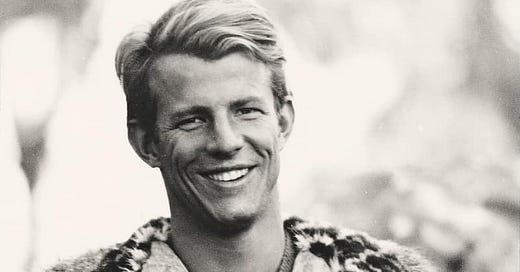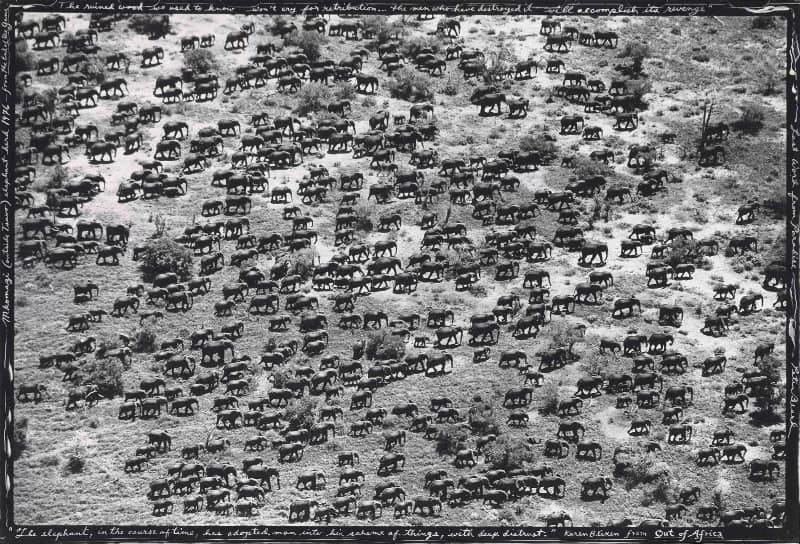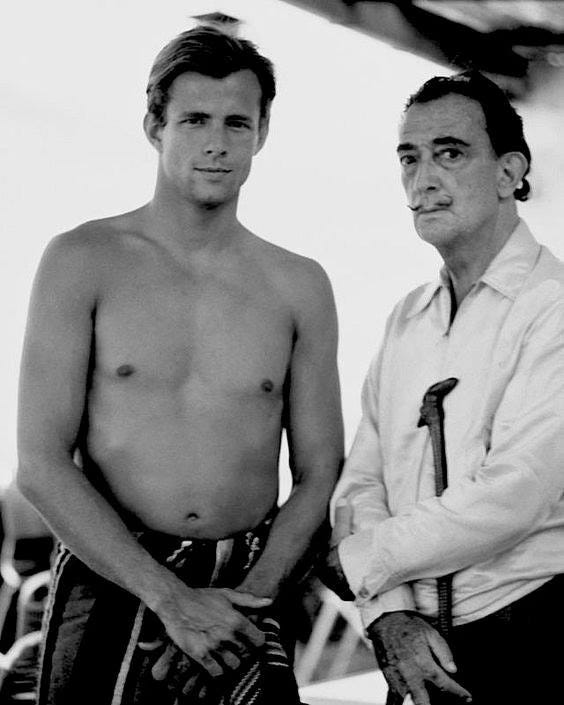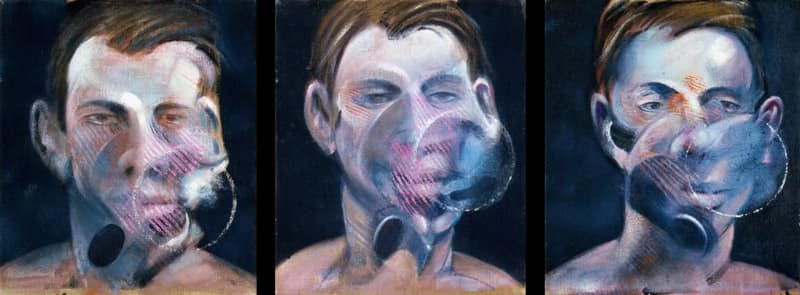Peter Beard was a celebrated photographer and artist known for his captivating wildlife photography and adventurous lifestyle. He studied art history at Yale, where his passion for Africa and conservation began. Beard became famous with his groundbreaking work The End of the Game, which highlighted the threats to African wildlife.
Table of Contents: Early Years / Africa / Rise to Fame / Flamboyant Lifestyle / Personal Life / Later years
If you aren’t subscribed yet, hit the subscribe button below to receive the Adorable Stories every weekend, directly in your inbox:
“He is half-Tarzan, half-Byron”
— Bob Colacello
Early years
Peter Hill Beard was born in Manhattan on January 22nd, 1938 into a distinguished family in New York City: his father, Anson McCook Beard Jr., was a successful railroad executive (his great grandfather was the railroad magnate James Jerome Hill), and his mother, Roseanne Hoar Beard, came from a line of wealthy industrialists.
The family’s affluence provided Peter with early exposure to art and culture.
A Voigtländer bellows camera given to him by a grandmother sparked a lifelong obsession with recording the people and things he saw around him, a habit that broadened to include painting, journal keeping, and collage making. He combined all of these forms in his artwork.
He would later recollect that his obvious artistic gifts were lost on his parents.
“Nobody said, ‘Your pictures are good’ or ‘You have a good eye,’ What they said was: “‘Good hobby. When are you going to do something worthwhile?’”
His father sent him to the prestigious Buckley School in Manhattan, followed by Pomfret School in Connecticut. Peter’s formative years were marked by summers in Newport, Rhode Island, where his fascination with nature began to take root.
Later, at Yale University, he dropped out of medical school and studied art history, further nurturing his passion for photography and exploration.
Peter began shooting fashion portfolios for Vogue while he was at Yale and kept a hand in magazine photography throughout his career.
His interest in photography blossomed in those years, influenced by the likes of Karen Blixen, the Danish author whose account of her life in Kenya was turned into the acclaimed Hollywood film Out of Africa.
Africa
In 1955, Peter traveled to Africa for the first time in the company of Quentin Keynes, a great-grandson of Charles Darwin: the African continent would become central to his life and work.
He was deeply moved by the natural beauty and the plight of wildlife, especially in Kenya. His passion for conservation was evident in his photographs, which often highlighted the threats to African wildlife.
In Kenya he met Karen Blixen and through her offices, Peter bought 45 acres of land in the Ngong Hills. After her death, Peter hired Blixen’s majordomo, Kamante (Kamadi Gaturo). Gaturo’s drawings on Beard’s photographs helped gain him recognition as an artist in his own right.
Rise to fame
Peter Beard became famous through his unique approach to photography and his adventurous lifestyle. His breakthrough came with the publication of The End of the Game in 1965, a book that combined his haunting photographs of African wildlife with personal diary entries and essays.
This work highlighted the devastating impact of human activity on Africa’s natural world, garnering critical acclaim.
Peter Beard’s art style was distinctive and innovative, merging photography with mixed media elements like collage, diary entries, and drawings.
He often used his own blood as a medium, adding a visceral and personal touch to his work. This unique approach created a sense of immediacy and raw emotion, blending the documentary nature of photography with the expressive qualities of fine art. His pieces frequently included handwritten notes and clippings, creating layered narratives that reflected his deep connection to both his subjects and his experiences. Beard’s art was a compelling commentary on nature, beauty, and the passage of time.
Flamboyant Lifestyle
In the 60s, Peter’s connections with prominent artists like Andy Warhol and Francis Bacon, as well as his presence in the London and New York art scenes, further propelled his fame. His captivating storytelling and charismatic personality made him a beloved figure both in the art world and beyond.
Peter split his time between New York and Kenya, where he owned Hog Ranch, near the Ngong Hills where his next-door neighbour became his personal hero Karen Blixen.
The Hog Ranch quickly estate became a creative hub, reflecting his deep connection to Africa’s wildlife and landscapes. His lifestyle was characterized by a blend of glamour and grit, often hosting parties with artists, celebrities, and conservationists.
Despite his affluent background, he embraced a rugged existence, immersing himself in the wild and often working in challenging conditions to capture the perfect shot.
His life looked like a seamless fusion of art, nature, and high society, embodying a spirit of exploration and creativity.
Peter’s cousin, the philanthropist Jerome Hill, introduced him to Salvador Dali in the early 1960s, the two quickly became friends and in 1963 they staged a mock protest of the Mona Lisa outside of the Metropolitan Museum of Art in New York (the painting was on a rare loan from the Louvre in Paris).
In the 1960s, Peter Beard met and became friends with Francis Bacon and the two shared a mutual appreciation for art and the unconventional. Their relationship was marked by lively discussions on art, life, and the human condition, often over long dinners and in artistic circles. Bacon’s influence is evident in Peter’s work, which often mirrored Bacon’s themes of existentialism and the visceral nature of existence.
“I don’t mind the word ‘dilettante.’ A dilettante means someone who does what he loves.”
— Peter Beard
In the early 1970s, Jerome Hill, who was also one of the first investors in Interview magazine, introduced Peter to Andy Warhol. Peter soon started taking photographs for the magazine and spending time at the Factory.
“I met him at a party and he talked to me for hours and hours about Nietzsche and Kierkegaard,” said the writer Bob Colacello, who was then the editor of Interview.
“He was absolutely mesmerizing, and when I told Andy about it, he said, ‘Oh, you’ve fallen for him, too.’”
In 1972, Rolling Stone magazine assigned Peter Beard to photograph the Rolling Stones during their “Exile on Main Street” tour. During this time, he became friends with Mick Jagger, who later attended his book parties. Peter Beard also connected with writers Truman Capote and Terry Southern, who were on assignment as well. His natural rapport with celebrities quickly made him a notable figure himself.
Personal Life
“The institution of marriage should be re-examined because of its overwhelming claustrophobia. The odds are stacked against spontaneity and effervescence.”
— Peter Beard
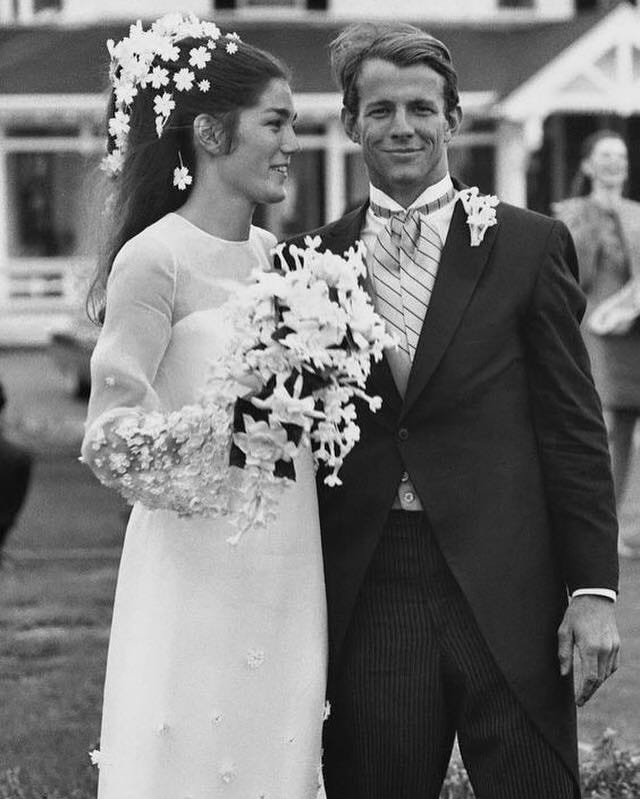
Peter Beard married three times:
His first marriage was to socialite Minnie Cushing (an heiress and assistant to the designer Oscar de la Renta) in August 1967 in an elaborate ceremony attended by a 21-person wedding party in Newport, Rhode Island. The reception was held at her family’s estate, the Ledges. The couple split three years later, and Peter entered Payne Whitney Psychiatric Clinic for two months after overdosing on barbiturates;
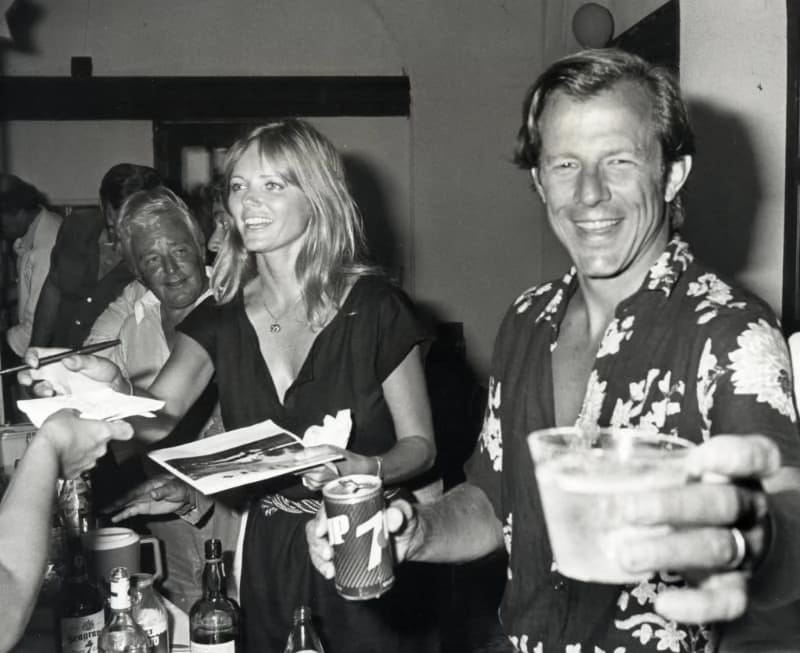
In 1982, Peter married supermodel Cheryl Tiegs (featured extensively in the Adorable Story #87), a union that lasted four years.
His third marriage was to Najma Khanum in 1986, with whom he had a daughter, Zara Beard.
In Kenya, Peter’s freewheeling lifestyle meant he often courted tragedy.
He swam in crocodile-infested rivers and, on more than one occasion, witnessed the death of someone who did not make it out of the water.
In 1996, while photographing near the Tanzanian border, Beard was charged by an elephant, impaled and trampled. On his way to hospital in Nairobi, he almost died of his internal injuries. By then, his reputation for recklessness was such that few of his African acquaintances were surprised by his brush with death.
After his recovery, his wife Najma took on a larger role managing his work and, increasingly, his social life.
Bob Colacello said he needed to slow down:
“Nejma probably saved him from an early death.”
Later years
In 2017, Peter Beard filed for bankruptcy, a culmination of financial challenges that had built up over the years.
These difficulties arose from costly legal battles (primarily over disputes related to his poorly managed artwork and real estate management) and the expenses of maintaining his properties and lifestyle in both New York and Kenya.
Despite his successful career and affluent family background, the financial demands of his adventurous lifestyle and extensive conservation efforts took a toll.
On top of this financial difficulties, in his later years Peter Beard began showing signs of dementia, which contributed to further challenges in managing his personal and professional affairs, thus also complicating his financial and legal situations.
Peter Beard disappeared in Montauk, Rhode Island, on March 31st, 2020 and was found dead on the following April 19th, 2020: his body was discovered in a nearby wooded area. He was 82 years old.
—Alberto @
Do you know anyone who would love to read this Adorable Story? Show your support by sharing Adorable Times’ Newsletter and earn rewards for your referrals.


